The History of Accessories in Anatolia
By Altan Ture*
The grand master of Turkish poetry, Bedri Rahmi Eyüboğlu, describes Anatolia as a Goddess.
Truthfully these lands have been rising on the world stage since the Neolithic Age. These lands have been home to the greatest cultures,which have reached their peaks.
The grand master of Turkish poetry, Bedri Rahmi Eyüboğlu, describes Anatolia as a Goddess.
Truthfully these lands have been rising on the world stage since the Neolithic Age. These lands have been home to the greatest cultures,which have reached their peaks.
The ships sailing on the surrounding seas brought the influence of Egyptian and Mesopotamian civilizations to Anatolia during the Bronze Age. Anatolia has always gathered these influences in its own pot and has created its own saying in culture and arts in all aspects of history.
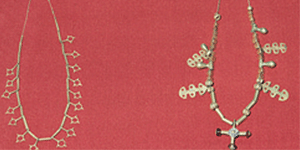
Anotolia is very rich in terms of natural resources, especially gold, silver, copper, lead and iron. The samples that have been brought to light at ancient settlements such as Çayönü and Çatalhöyük are among the oldest examples of jewelry in human history, made of solid copper and lead.
Surprisingly beautiful tools made of bone and stone were also found there. The art of jewelry in Anatolia goes back to 4000 BC, reached its peak in 3000 BC, and has been developing ever since then.
THE BRONZE AGE
The discoveries made in years 1935-36 at Alacahoyuk have proven the existence of a well developed jewelry art in the northern part of middle Anatolia during the early Bronze Age.
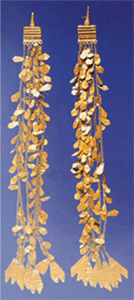
The graves of 13 kings belonging to the period of 3000 BC have been discovered, containing magnificent presents including gold jewelry and belongings.
In the Horoztepe and Mahmatlar regions there were discoveries of gold and silver of the same period. The Anatolian jewelry makers created moldings with their own styles without being influenced by Egyptians and Mesopotamian techniques.
Troy, the city of legends located at a point overlooking the Dardanelles Strait (Çanakkale), created a more dynamic synthesis because it controlled sea-trade routes and it was open to the influences coming through the Balkans.
In the II.G layer of the Troy mound, the group of treasures taken out from the mass of ruins of palaces destroyed by a strong fire, were found signs of riches obtained and the production of very different styles of jewelry. Trojans didn’t use ornamental stones. But they worked with the simple impressiveness of gold and skillfully adorned the first granulation works of Anatolia.
The Hittite kingdom was founded in 2000 BC and spread out to Northern Mesopotamia to become one of the biggest military powers in that age. State archives, including thousands of clay tablets with cuneiform texts which were found in Hattusa, the capital city of the Hittites, document the huge stock of metal belonging to the kingdom’s treasury.
Marriage agreements inside these documents containing the list of valuable gifts of jewelry given to brides, temple inventories mention small statues made in gold and silver presented to the polytheistic then and gifts of jewelry to the temples.
Because of the downfall of the kingdom after sudden attacks by seafaring nations and the burning and plundering of the cities, only a few pieces of Hittite jewelry have reached us.
Seal rings and pendants inn the shape of gods and goddesses, as well as a few gifts of jewelry let us recognize the art of the Hittites.
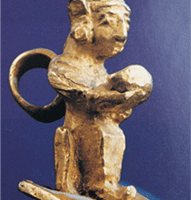
MASTERS OF THE METAL WORKING
After the Dark Ages, whichs continued until 800 BC, new political nations formed In Anatolia.
A Late Hittite governmental site in Southeast Anatolia, Urartia in East Anatolia, Phrygia in middle Anatolia and the kingdom of Lydia kingdom in west Anatolia were founded.
City-states founded by colonists moving out from Greece started to grow along the Aegean coastline.
Many gifts of jewelry made in gold, silver and bronze by the Urartians, who were masters of metal working art, have reached us, including hairclips, brooches, buckles / clasps, necklaces, bracelets and crescent-shaped pectorals, which are a kind of badge worn on the chest as a symbol of rank by men.
Such items demonstrate that both women and men liked wearing gifts of jewelry.
These pieces show monumental expression, symmetrical arrangements and architectural elements and the characteristic of using patterns in decorative objects.
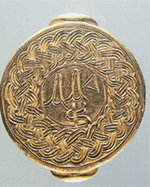
PHRYGIA, THE COUNTRY OF MIDAS OF THE GOLDEN TOUCH
Phrygians came to middle Anatolia through the Balkans and settled down there in the 1200’s BC. They founded a kingdom with Gordion as the capital city.
Phrygia was very rich in terms of natural resources, especially silver, lead, hematite mines, quartz, and onyx stratums, and was famous for exporting bronze and silver pots and pans.
Phrygian pots with pulley shaped handles made their way to the farthest points of the ancient world.
Phrygians created their own Anatolian style. Their contributions to Anatolian art were fine workmanship and geometrical patterns designed carefully.
Some silver belts found at digs in a Phrygian tumulus located near Elmalı, a town of Antalya province, were also adorned by these patterns.
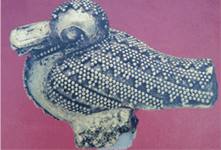
The Phrygian kingdom collapsed in the 7th century BC due to the quick and merciless attacks of the Cimmerians, and its valuable ore stocks and jewelry pieces were plundered.
Therefore we have no enough information about gold jewelry pieces by the Phrygians.
However, many bronze fibulas and some sliver fibulas have come down to us and show that the Phrygians were responsible for many unique contributions to the art of jewelry making.
THE KINGDOM OF LYDIA
The blessed basin of the rivers Gediz (Hermos), Bakırçay (Kaykos), Küçük Menderes (Kaytros) was called Lydia in ancient times. The roots of the Lydian people, the date of their arrival in this region and their origin are unknown.
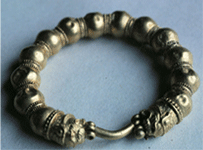
The founding of their kingdom is explained only by certain vague legends. But, the most important thing is the extraordinary wealth which has reached us indirectly.
The main source of this wealth was the gold mined extracted from the Paktolos stream, which flows through Sardes, the capital city of Lydia.
The known oldest gold refinery in Anatolia was brought to light by an archeological dig in Sardes in 1968.
It was an integrated gold purifying refinery, using the Cupellation technique, and included jewelry workshops.
Pieces of quartz, agate and sardonyx taken out from the Sardes dig prove that the Lydian people were craftsmen in the field of gemology.
ORIENTAL STYLE
Greek colonies settled on the West Anatolian seaside began sea trading between the years 600-650 BC and Ionians established new colonies under the leadership of Miletos on the seacoast of Egypt, the East Mediterranean and the Black sea.
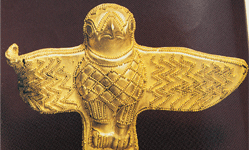
Together with the luxury items brought from the Middle East and Egypt, the sphinx and gryphon patterns and Lotus flower taken from the rich mythology of East added new looks to Ionian art. Greek artists had been stuck in the hard lines of the geometrical style up to that time, but now they made works of art similar to those of the East by using gold, bronze and ivory with Ionian soft style and Anatolian lively expression.
This style, called Orientalism, is a cultural synthesis of some of Anatolian civilizations, such as the immigrant Achaeans, the Anatolian-originated Lydians and the Phrygians who became Anatolian. It is also a mix of West and East using as its base the Anatolian style.
Bracelets which end with animal figures and were adorned with Silver Filigree (Telkari) and Granulation styled ornaments, necklaces made in the shape of pine cones, brooches adorned with some figures at the head, fibulas, and some other kinds of pieces of jewelry were also created in the Orientalisan style.
Orientalisan styled jewelry pieces presented to the goddess as offerings in the Temple of Artemis in Ephesus are very nice examples of this art. But still it is not known yet whether they were made by Ionians or Lydians.
However, it is not surprising that the Lydians become leaders in this kind of art with their powerful tradition in gold mining and working of ornamental stones.
PERSIAN DOMINATION
Persian domination in Anatolia started with the defeat of the kingdom of Lydia in the year 546 BC by Kros, who was the king of the Persian Empire.
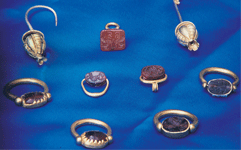
This domination by the Persians continued for 200 years in Anatolia.
The Persians had a deep-seated tradition of palace art and protected the art as a as a means to spread their propaganda of the power of the Empire.
They affected the structure of art in Anatolia. The jewelry products made at this period of time in Anatolia arouse interest with their features such as imposing design, superior workmanship and colorful compositions made by enamel and ornamental stones.
The heads of lions, calves, geese, as well as complete figures of other animals were the most important area of jewelry design.
Also triangle or diamond shaped groups of granulations and other ornaments are characteristic in style of this period.
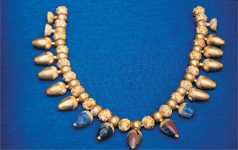
Large groups of pieces, consisting of many golden gifts of jewelry and pots made in silver, some of them inlaid with gold, found and plundered by illicit diggings in Tumuluses near Uşak province were sold to the Metropolitan Museum of Art in NY.
All these examples show that Anatolian jewelry work reached its peak in the 6th century BC. These magnificent works of arts called The treasure of Karun were the masterpieces of Lydian and Ionian artists.
THE HELLENISTIC PERIOD AND ROMAN EMPIRE
In the period of the domination of Persians, the most important centers of jewelry work were Sardes and Lapokas near Çanakkale strait (Dardanelles). In the enthusiastic style which joins together the cultures of West and East of the Hellenistic period, new and imposing patterns were created by combining jewelry designs taken from 6-5th century BC.
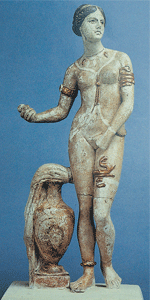
Golden chains adorned with human or animal heads, unadorned band shaped necklaces and earrings with human figures, birds, or goddesses, are examples of the patterns created in this period. The most interesting of these new patterns is a new type of body ornament; it has four chains that go out from the main part under the breast and wraps around the body diagonally.
The passion of color and display taken from Persian art shows itself in Hellenistic pieces with their use of very colorful arrangements of precious stones, such as enamel, garnet, emerald, sapphire, agate, and pearl.
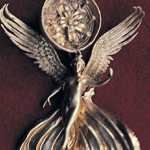
The Heracles knot taken from Egyptian art and Isis Hother patterns were some other influences on jewelry design. In the period of the Roman Empire, the unadorned but impressive forms of jewelry pieces and the use of more precious stones affected Anatolian jewelry making.
* Archeologist Altan Ture, Goldas Jewelry Consultant
Jewelry Special Issue, October 2006

Anotolia is very rich in terms of natural resources, especially gold, silver, copper, lead and iron. The samples that have been brought to light at ancient settlements such as Çayönü and Çatalhöyük are among the oldest examples of jewelry in human history, made of solid copper and lead.
Surprisingly beautiful tools made of bone and stone were also found there. The art of jewelry in Anatolia goes back to 4000 BC, reached its peak in 3000 BC, and has been developing ever since then.
THE BRONZE AGE
The discoveries made in years 1935-36 at Alacahoyuk have proven the existence of a well developed jewelry art in the northern part of middle Anatolia during the early Bronze Age.

The graves of 13 kings belonging to the period of 3000 BC have been discovered, containing magnificent presents including gold jewelry and belongings.
In the Horoztepe and Mahmatlar regions there were discoveries of gold and silver of the same period. The Anatolian jewelry makers created moldings with their own styles without being influenced by Egyptians and Mesopotamian techniques.
Troy, the city of legends located at a point overlooking the Dardanelles Strait (Çanakkale), created a more dynamic synthesis because it controlled sea-trade routes and it was open to the influences coming through the Balkans.
In the II.G layer of the Troy mound, the group of treasures taken out from the mass of ruins of palaces destroyed by a strong fire, were found signs of riches obtained and the production of very different styles of jewelry. Trojans didn’t use ornamental stones. But they worked with the simple impressiveness of gold and skillfully adorned the first granulation works of Anatolia.
The Hittite kingdom was founded in 2000 BC and spread out to Northern Mesopotamia to become one of the biggest military powers in that age. State archives, including thousands of clay tablets with cuneiform texts which were found in Hattusa, the capital city of the Hittites, document the huge stock of metal belonging to the kingdom’s treasury.
Marriage agreements inside these documents containing the list of valuable gifts of jewelry given to brides, temple inventories mention small statues made in gold and silver presented to the polytheistic then and gifts of jewelry to the temples.
Because of the downfall of the kingdom after sudden attacks by seafaring nations and the burning and plundering of the cities, only a few pieces of Hittite jewelry have reached us.
Seal rings and pendants inn the shape of gods and goddesses, as well as a few gifts of jewelry let us recognize the art of the Hittites.

MASTERS OF THE METAL WORKING
After the Dark Ages, whichs continued until 800 BC, new political nations formed In Anatolia.
A Late Hittite governmental site in Southeast Anatolia, Urartia in East Anatolia, Phrygia in middle Anatolia and the kingdom of Lydia kingdom in west Anatolia were founded.
City-states founded by colonists moving out from Greece started to grow along the Aegean coastline.
Many gifts of jewelry made in gold, silver and bronze by the Urartians, who were masters of metal working art, have reached us, including hairclips, brooches, buckles / clasps, necklaces, bracelets and crescent-shaped pectorals, which are a kind of badge worn on the chest as a symbol of rank by men.
Such items demonstrate that both women and men liked wearing gifts of jewelry.
These pieces show monumental expression, symmetrical arrangements and architectural elements and the characteristic of using patterns in decorative objects.

PHRYGIA, THE COUNTRY OF MIDAS OF THE GOLDEN TOUCH
Phrygians came to middle Anatolia through the Balkans and settled down there in the 1200’s BC. They founded a kingdom with Gordion as the capital city.
Phrygia was very rich in terms of natural resources, especially silver, lead, hematite mines, quartz, and onyx stratums, and was famous for exporting bronze and silver pots and pans.
Phrygian pots with pulley shaped handles made their way to the farthest points of the ancient world.
Phrygians created their own Anatolian style. Their contributions to Anatolian art were fine workmanship and geometrical patterns designed carefully.
Some silver belts found at digs in a Phrygian tumulus located near Elmalı, a town of Antalya province, were also adorned by these patterns.

The Phrygian kingdom collapsed in the 7th century BC due to the quick and merciless attacks of the Cimmerians, and its valuable ore stocks and jewelry pieces were plundered.
Therefore we have no enough information about gold jewelry pieces by the Phrygians.
However, many bronze fibulas and some sliver fibulas have come down to us and show that the Phrygians were responsible for many unique contributions to the art of jewelry making.
THE KINGDOM OF LYDIA
The blessed basin of the rivers Gediz (Hermos), Bakırçay (Kaykos), Küçük Menderes (Kaytros) was called Lydia in ancient times. The roots of the Lydian people, the date of their arrival in this region and their origin are unknown.

The founding of their kingdom is explained only by certain vague legends. But, the most important thing is the extraordinary wealth which has reached us indirectly.
The main source of this wealth was the gold mined extracted from the Paktolos stream, which flows through Sardes, the capital city of Lydia.
The known oldest gold refinery in Anatolia was brought to light by an archeological dig in Sardes in 1968.
It was an integrated gold purifying refinery, using the Cupellation technique, and included jewelry workshops.
Pieces of quartz, agate and sardonyx taken out from the Sardes dig prove that the Lydian people were craftsmen in the field of gemology.
ORIENTAL STYLE
Greek colonies settled on the West Anatolian seaside began sea trading between the years 600-650 BC and Ionians established new colonies under the leadership of Miletos on the seacoast of Egypt, the East Mediterranean and the Black sea.

Together with the luxury items brought from the Middle East and Egypt, the sphinx and gryphon patterns and Lotus flower taken from the rich mythology of East added new looks to Ionian art. Greek artists had been stuck in the hard lines of the geometrical style up to that time, but now they made works of art similar to those of the East by using gold, bronze and ivory with Ionian soft style and Anatolian lively expression.
This style, called Orientalism, is a cultural synthesis of some of Anatolian civilizations, such as the immigrant Achaeans, the Anatolian-originated Lydians and the Phrygians who became Anatolian. It is also a mix of West and East using as its base the Anatolian style.
Bracelets which end with animal figures and were adorned with Silver Filigree (Telkari) and Granulation styled ornaments, necklaces made in the shape of pine cones, brooches adorned with some figures at the head, fibulas, and some other kinds of pieces of jewelry were also created in the Orientalisan style.
Orientalisan styled jewelry pieces presented to the goddess as offerings in the Temple of Artemis in Ephesus are very nice examples of this art. But still it is not known yet whether they were made by Ionians or Lydians.
However, it is not surprising that the Lydians become leaders in this kind of art with their powerful tradition in gold mining and working of ornamental stones.
PERSIAN DOMINATION
Persian domination in Anatolia started with the defeat of the kingdom of Lydia in the year 546 BC by Kros, who was the king of the Persian Empire.

This domination by the Persians continued for 200 years in Anatolia.
The Persians had a deep-seated tradition of palace art and protected the art as a as a means to spread their propaganda of the power of the Empire.
They affected the structure of art in Anatolia. The jewelry products made at this period of time in Anatolia arouse interest with their features such as imposing design, superior workmanship and colorful compositions made by enamel and ornamental stones.
The heads of lions, calves, geese, as well as complete figures of other animals were the most important area of jewelry design.
Also triangle or diamond shaped groups of granulations and other ornaments are characteristic in style of this period.

Large groups of pieces, consisting of many golden gifts of jewelry and pots made in silver, some of them inlaid with gold, found and plundered by illicit diggings in Tumuluses near Uşak province were sold to the Metropolitan Museum of Art in NY.
All these examples show that Anatolian jewelry work reached its peak in the 6th century BC. These magnificent works of arts called The treasure of Karun were the masterpieces of Lydian and Ionian artists.
THE HELLENISTIC PERIOD AND ROMAN EMPIRE
In the period of the domination of Persians, the most important centers of jewelry work were Sardes and Lapokas near Çanakkale strait (Dardanelles). In the enthusiastic style which joins together the cultures of West and East of the Hellenistic period, new and imposing patterns were created by combining jewelry designs taken from 6-5th century BC.

Golden chains adorned with human or animal heads, unadorned band shaped necklaces and earrings with human figures, birds, or goddesses, are examples of the patterns created in this period. The most interesting of these new patterns is a new type of body ornament; it has four chains that go out from the main part under the breast and wraps around the body diagonally.
The passion of color and display taken from Persian art shows itself in Hellenistic pieces with their use of very colorful arrangements of precious stones, such as enamel, garnet, emerald, sapphire, agate, and pearl.

The Heracles knot taken from Egyptian art and Isis Hother patterns were some other influences on jewelry design. In the period of the Roman Empire, the unadorned but impressive forms of jewelry pieces and the use of more precious stones affected Anatolian jewelry making.
* Archeologist Altan Ture, Goldas Jewelry Consultant
Jewelry Special Issue, October 2006
Last modified onSaturday, 06 May 2017 10:07
Tagged under
Latest from Admin TOA
- Fat Sal’s Italian Specialties Welcomes Customers in Bayville, NJ with a Renewed Concept
- FFD Wood LLC Delivers Custom Woodwork Solutions from Long Island
- A Tax Expert in the U.S. Tax World: An Interview with Samet Oynamıs
- Announcing the 2025 Edition of the 100 Most Influential Turkish Americans
- CEO Club New York Networking Night Stands Out with the Lamborghini Experience









